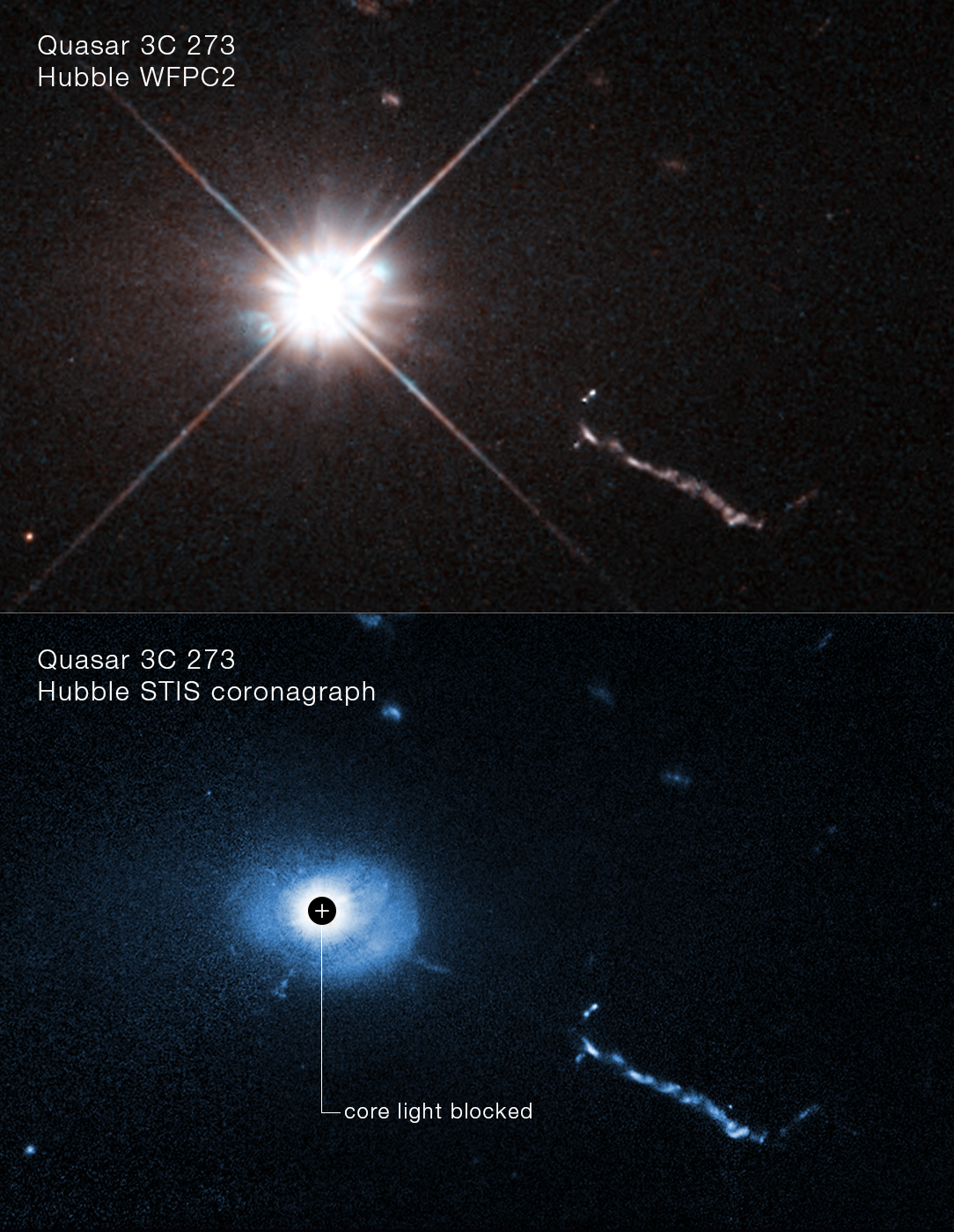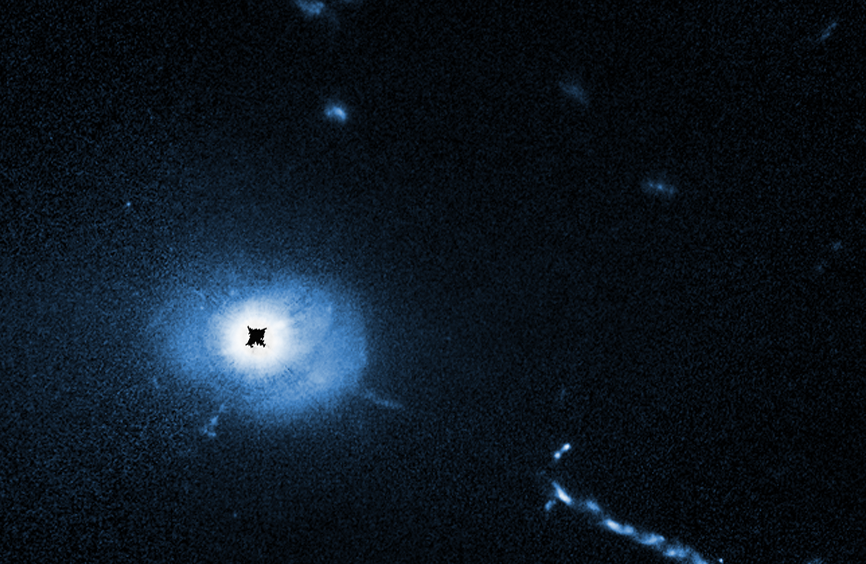Hubble Space Telescope Home NASA’s Hubble Takes the… Hubble Space Telescope Hubble Home Overview About Hubble The History of Hubble Hubble Timeline Why Have a Telescope in Space? Hubble by the Numbers At the Museum FAQs Impact & Benefits Hubble’s Impact & Benefits Science Impacts Cultural Impact Technology Benefits Impact on Human Spaceflight Astro Community Impacts Science Hubble Science Science Themes Science Highlights Science Behind Discoveries Hubble’s Partners in Science Universe Uncovered Explore the Night Sky Observatory Hubble Observatory Hubble Design Mission Operations Missions to Hubble Hubble vs Webb Team Hubble Team Career Aspirations Hubble Astronauts News Hubble News Hubble News Archive Social Media Media Resources Multimedia Multimedia Images Videos Sonifications Podcasts E-books Online Activities Lithographs Fact Sheets Glossary Posters Hubble on the NASA App More 35th Anniversary 4 Min Read NASA’s Hubble Takes the Closest-Ever Look at a Quasar  A NASA Hubble Space Telescope image of the core of quasar 3C 273. Credits:
A NASA Hubble Space Telescope image of the core of quasar 3C 273. Credits:
NASA, ESA, Bin Ren (Université Côte d’Azur/CNRS); Acknowledgment: John Bahcall (IAS); Image Processing: Joseph DePasquale (STScI) Astronomers have used the unique capabilities of NASA’s Hubble Space Telescope to peer closer than ever into the throat of an energetic monster black hole powering a quasar. A quasar is a galactic center that glows brightly as the black hole consumes material in its immediate surroundings.
The new Hubble views of the environment around the quasar show a lot of “weird things,” according to Bin Ren of the Côte d’Azur Observatory and Université Côte d’Azur in Nice, France. “We’ve got a few blobs of different sizes, and a mysterious L-shaped filamentary structure. This is all within 16,000 light-years of the black hole.”
Some of the objects could be small satellite galaxies falling into the black hole, and so they could offer the materials that will accrete onto the central supermassive black hole, powering the bright lighthouse. “Thanks to Hubble’s observing power, we’re opening a new gateway into understanding quasars,” said Ren. “My colleagues are excited because they’ve never seen this much detail before.”
Quasars look starlike as point sources of light in the sky (hence the name quasi-stellar object). The quasar in the new study, 3C 273, was identified in 1963 by astronomer Maarten Schmidt as the first quasar. At a distance of 2.5 billion light-years it was too far away for a star. It must have been more energetic than ever imagined, with a luminosity over 10 times brighter than the brightest giant elliptical galaxies. This opened the door to an unexpected new puzzle in cosmology: What is powering this massive energy production? The likely culprit was material accreting onto a black hole.
 A Hubble Space Telescope image of the core of quasar 3C 273. A coronagraph on Hubble blocks out the glare coming from the supermassive black hole at the heart of the quasar. This allows astronomers to see unprecedented details near the black hole such as weird filaments, lobes, and a mysterious L-shaped structure, probably caused by small galaxies being devoured by the black hole. Located 2.5 billion light-years away, 3C 273 is the first quasar (quasi-stellar object) ever discovered, in 1963. NASA, ESA, Bin Ren (Université Côte d’Azur/CNRS); Acknowledgment: John Bahcall (IAS); Image Processing: Joseph DePasquale (STScI) In 1994 Hubble’s new sharp view revealed that the environment surrounding quasars is far more complex than first suspected. The images suggested galactic collisions and mergers between quasars and companion galaxies, where debris cascades down onto supermassive black holes. This reignites the giant black holes that drive quasars.
A Hubble Space Telescope image of the core of quasar 3C 273. A coronagraph on Hubble blocks out the glare coming from the supermassive black hole at the heart of the quasar. This allows astronomers to see unprecedented details near the black hole such as weird filaments, lobes, and a mysterious L-shaped structure, probably caused by small galaxies being devoured by the black hole. Located 2.5 billion light-years away, 3C 273 is the first quasar (quasi-stellar object) ever discovered, in 1963. NASA, ESA, Bin Ren (Université Côte d’Azur/CNRS); Acknowledgment: John Bahcall (IAS); Image Processing: Joseph DePasquale (STScI) In 1994 Hubble’s new sharp view revealed that the environment surrounding quasars is far more complex than first suspected. The images suggested galactic collisions and mergers between quasars and companion galaxies, where debris cascades down onto supermassive black holes. This reignites the giant black holes that drive quasars.
For Hubble, staring into the quasar 3C 273 is like looking directly into a blinding car headlight and trying to see an ant crawling on the rim around it. The quasar pours out thousands of times the entire energy of stars in a galaxy. One of closest quasars to Earth, 3C 273 is 2.5 billion light-years away. (If it was very nearby, a few tens of light-years from Earth, it would appear as bright as the Sun in the sky!) Hubble’s Space Telescope Imaging Spectrograph (STIS) can serve as a coronagraph to block light from central sources, not unlike how the Moon blocks the Sun’s glare during a total solar eclipse. Astronomers have used STIS to unveil dusty disks around stars to understand the formation of planetary systems, and now they can use STIS to better understand quasars’ host galaxies. The Hubble coronograph allowed astronomers to look eight times closer to the black hole than ever before.
Scientists got rare insight into the quasar’s 300,000-light-year-long extragalactic jet of material blazing across space at nearly the speed of light. By comparing the STIS coronagraphic data with archival STIS images with a 22-year separation, the team led by Ren concluded that the jet is moving faster when it is farther away from the monster black hole.
“With the fine spatial structures and jet motion, Hubble bridged a gap between the small-scale radio interferometry and large-scale optical imaging observations, and thus we can take an observational step towards a more complete understanding of quasar host morphology. Our previous view was very limited, but Hubble is allowing us to understand the complicated quasar morphology and galactic interactions in detail. In the future, looking further at 3C 273 in infrared light with the James Webb Space Telescope might give us more clues,” said Ren.
At least 1 million quasars are scattered across the sky. They are useful background “spotlights” for a variety of astronomical observations. Quasars were most abundant about 3 billion years after the big bang, when galaxy collisions were more common.
The Hubble Space Telescope has been operating for over three decades and continues to make ground-breaking discoveries that shape our fundamental understanding of the universe. Hubble is a project of international cooperation between NASA and ESA (European Space Agency). NASA’s Goddard Space Flight Center in Greenbelt, Maryland, manages the telescope and mission operations. Lockheed Martin Space, based in Denver, also supports mission operations at Goddard. The Space Telescope Science Institute (STScI) in Baltimore, which is operated by the Association of Universities for Research in Astronomy, conducts Hubble science operations for NASA.
Explore More
Science Behind the Discoveries: Quasars
Science Behind the Discoveries: Black Holes
Monster Black Holes are Everywhere
Facebook logo @NASAHubble @NASAHubble Instagram logo @NASAHubble Media Contacts:
Claire Andreoli (claire.andreoli@nasa.gov)
NASA’s Goddard Space Flight Center, Greenbelt, MD
Ray Villard
Space Telescope Science Institute, Baltimore, MD
Science Contact:
Bin Ren
Université Côte d’Azur, Observatoire de la Côte d’Azur, CNRS, France
Details Last Updated Dec 05, 2024 Editor Andrea Gianopoulos Location NASA Goddard Space Flight Center Related Terms Astrophysics Astrophysics Division Goddard Space Flight Center Hubble Space Telescope Quasars
Keep Exploring Discover More Topics From Hubble Hubble Space Telescope
Since its 1990 launch, the Hubble Space Telescope has changed our fundamental understanding of the universe.






